Okay, here we go. On January 1, 2023, The Department of Energy (DOE) implemented new minimum efficiency standards for residential and commercial HVAC equipment. These regulations aim to reduce energy consumption and make HVAC systems more efficient and sustainable. Let’s dive into the key changes and how they affect SEER, EER, and HSPF ratings, to help you make an informed decision on your next HVAC purchase.
Have a heating, cooling, or plumbing problem, but no time to wait for a repairman? Need a second opinion on an existing quote?
We’ll give you free advice about your question or problem. In many cases, you’ll get an estimate or the help you need during the video call.
A higher rating not only indicates greater energy efficiency but also translates to improved comfort and lower monthly energy costs. Purchasing a unit with a higher rating may have a higher cost upfront, but it can save you money in the long run.
Minimum Efficiency Requirements
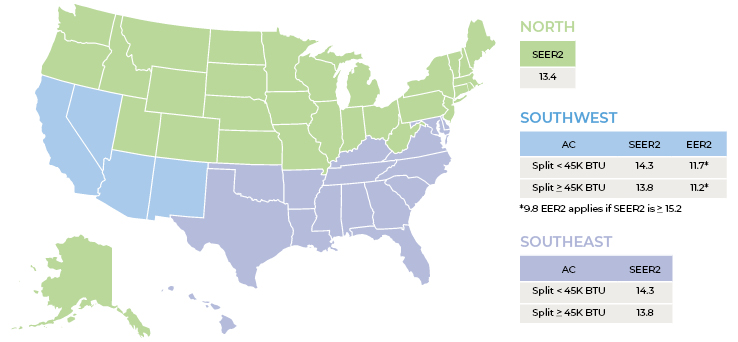
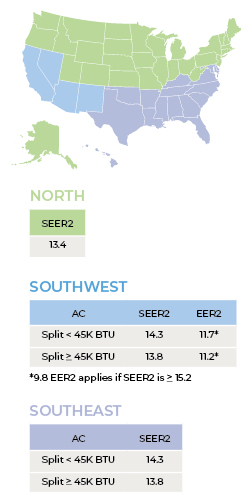
SEER2: A New Measure of Cooling Efficiency
The Difference Between SEER and SEER2
One significant change in the 2023 regulations is the introduction of SEER2, an updated version of SEER (Seasonal Energy Efficiency Ratio) for air conditioners and heat pumps.
Under the previous SEER protocols, the testing conditions did not properly account for the influence of ductwork on external static pressure. As a result, the external static test pressure often fell short of replicating real-world applications. To address this, SEER2 has raised the total external static pressure testing conditions, which more accurately resembles real-world scenarios.
How SEER2 Works
SEER2 measures air conditioner and heat pump cooling efficiency by calculating the cooling output over a typical cooling season and dividing it by the total electric energy input during the same period. The new SEER2 metric also includes a new M1 blower testing procedure, which uses a higher static pressure for a more accurate reflection of real-life conditions.
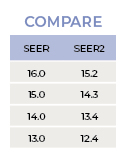

Understanding SEER2 Ratings
With the new SEER2 criteria, your current system may be considered less efficient. Make sure to check your home’s equipment to see if it meets the minimum ratings. Ultimately, there is no magic SEER2 number; anything over the minimum rating of 13.4 is excellent. Replacing an older, less efficient system with a higher SEER2 unit can substantially reduce cooling costs.
EER vs. EER2: How do these compare?
When evaluating the energy efficiency of air conditioners, two distinct ratings, EER2 and SEER2, consider different temperature conditions. EER2 (Energy Efficiency Ratio) focuses on measuring an air conditioner's efficiency at the peak cooling temperature of 95°F, offering a specific data point for performance. In contrast, SEER2, or Seasonal Energy Efficiency Rating, assesses an air conditioner's efficiency across an entire cooling season, accounting for temperatures ranging from 65°F to 104°F, providing an average of AC efficiency.
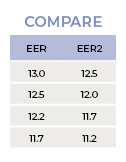

The transition from EER to EER2 has introduced a 4.1% reduction in ratings, with the new EER2 ratings subjected to more rigorous test conditions, featuring external static pressure (ESP) that is five times higher. The change in test conditions results in a different numerical value compared to the original EER rating. This adjustment better aligns with real-life conditions and usage of split-system, window, and portable air conditioners.
HSPF vs. HSPF2: What’s the difference?
Unlike SEER2 and EER2, HSPF2 doesn't evaluate cooling efficiency. Like the old HSPF (Heating Seasonal Performance Factor) ratings, HSPF2 ratings determine the energy efficiency of a heat pump when warming your home in Heat Mode.
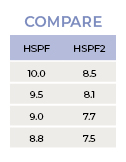

The primary difference between HSPF and HSPF2 lies in the testing conditions. HSPF2 tests are conducted to replicate the harsher weather conditions typical heat pumps encounter when extracting heat from outdoor air. This results in HSPF2 ratings being approximately 15% lower than HSPF ratings.
We get it. This is really boring information. It’s confusing and you’re hoping there won’t be a test on it afterwards.
Just give us a call to schedule a free over-the-phone evaluation. Our technicians can help you find an energy-saving solution tailored to your home. Don't forget to explore available tax credits, manufacturer rebates, or financing to help with the cost of a new system for your home. Call 812-339-9114 or schedule online today!



